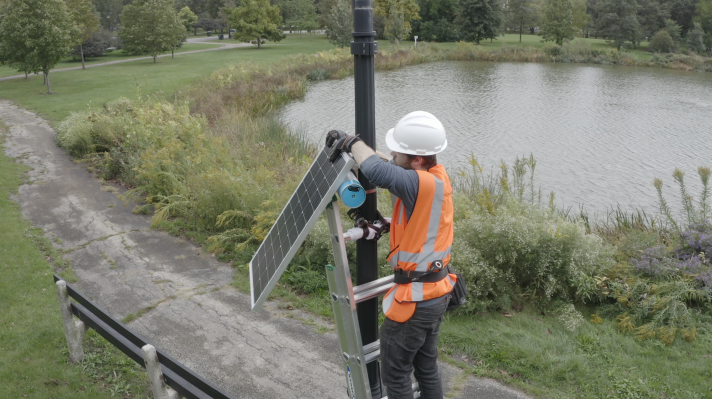If you’re standing at the water’s edge of the San Francisco Bay, chances are that you have half a dozen high-speed internet providers clamoring for your attention, eager to give you gigabits of internet. That isn’t the case for billions of people in rural communities around the world, who often have to make do with sub-par — if any — service. That’s the market Mesh++ is aiming to serve, and the company just snagged a couple of sacks of cash to help them realize its mission. Headquartered in Chicago and Nairobi, the team is focused on bringing internet connectivity to rural and underserved communities.
On paper, the solution is elegant. You plug a wireless router into power, and the router looks for other nearby Mesh++ routers. They connect and share any available internet connectivity across the mesh network. Each router becomes a node, further spreading the Wi-Fi love across the land. The company claims a single node can blanket 10 acres of Wi-Fi connectivity, supporting up to 100 people. If a local internet connection goes down due to connectivity or power failure, the rest of the network picks up the slack — and if there’s a full breakdown, the network can be used for internal communication, including messaging and news alerts within the network.
The internet connection can come from anywhere — whether via ethernet, via cellular modems, via multiple points — you have a set of Ethernet or cellular modems, throughout the network, and you’re able to aggregate the bandwidth from all those sources. So that creates a redundant network where if one of those fails the others can fill in. The cool thing about that, versus having a set of separate networks that are all fed separately, is that it creates a very trusted network where, for example, you might be deploying a fiber network in a very old city where the fiber infrastructure is already starting to fail. And having a network like this, that can aggregate the sources, means you can trust a normally untrusted source, because if it fails, nothing really major happens. So, we can create very resilient networks.
In addition to routine connectivity when everything is working as planned, the network should be able to survive disaster situations. This was tested a couple of years ago, when Hurricane Ida knocked out a huge swathe of connectivity across New Orleans; the company claims its network continued without any downtime.
Of course, there is no shortage of plays for rural and remote internet connectivity, but I’m struck by how Mesh++’s solution is coming at the challenge from a place of access and equality. It is certainly more equalitarian than Elon Musk’s Starlink, to pick an example out of outer space, but at the same time it is easy to imagine a combination of Starlink for internet gateway purposes and Mesh++ for the local distribution of rural internet connectivity.
“There are a number of companies out there who can give you gigabit internet connections anywhere in the world,” says Mesh++’s CEO Danny Gardner, suggesting that Starlink may, in fact, be a good fit. “It would be a dream partnership. The challenge that a lot of these companies face, is that you can, in theory, serve a few hundred people per satellite, and the last-mile internet connectivity is the challenge. For them, partnering with a technology like ours that can get connectivity to anywhere, we will be able to connect the world’s remaining 3 billion people.”
The company is betting that it can out-execute even the big cellular data providers, and the team seems pretty unfazed by the competition offered by LTE or 5G networks.
“Look, T-Mobile promised to cover most of the U.S. with sub 6 Ghz 5G connectivity. But the truth is that if they haven’t covered it yet with 4G because they determined that wasn’t financially sustainable, then it’s not gonna happen with 5G either,” Gardner surmises.
In addition to having built out test networks in a number of American cities, the company has a presence in Nairobi, with a five-person subsidiary there.
“When we first started the company, it was primarily geared towards emerging markets and the need for internet access,” says Gardner. “At first, we didn’t realize how big of a problem it is here at home in the U.S. Slowly over time, we shifted more towards fixing the connectivity problems in our own backyard.”
Mesh++ has raised a $4.9 million seed led by impact investor World Within, with participation from new investors Lateral Capital, Anorak Ventures, First Leaf Capital and existing investors SOSV, GAN Ventures, TechNexus and Illinois Ventures. In the early days of its life, the company was part of the HAX hardware pre-seed program.
“The fundraising marks a major shift in the company, from a pure R&D-driven company over the past few years, and towards focusing more on sales, and turning the company into a more mature organization,” says Gardner. “The fundraising unlocks us being able to partner with customers and distributors to connect as many people as possible, and to get the product out there.”
The company is playing into the macro-economic trend of ensuring that every home in the U.S. can be covered by internet connections. There is lots of funding available for last-mile networks, especially in the U.S. — now over $80 billion in the last few years. That’s not enough for fiber to every home — the economics and logistics of that only works in areas with higher population densities. This is where mesh networks might just be the key. Mesh++ claims that its technology cuts the infrastructure cost for installation from more than $400 per household to $29 or thereabouts. The savings are primarily in the labor costs and ease of installation, rather than the cost of the hardware that needs to be installed on-site.
Credit: Source link


Comments are closed.